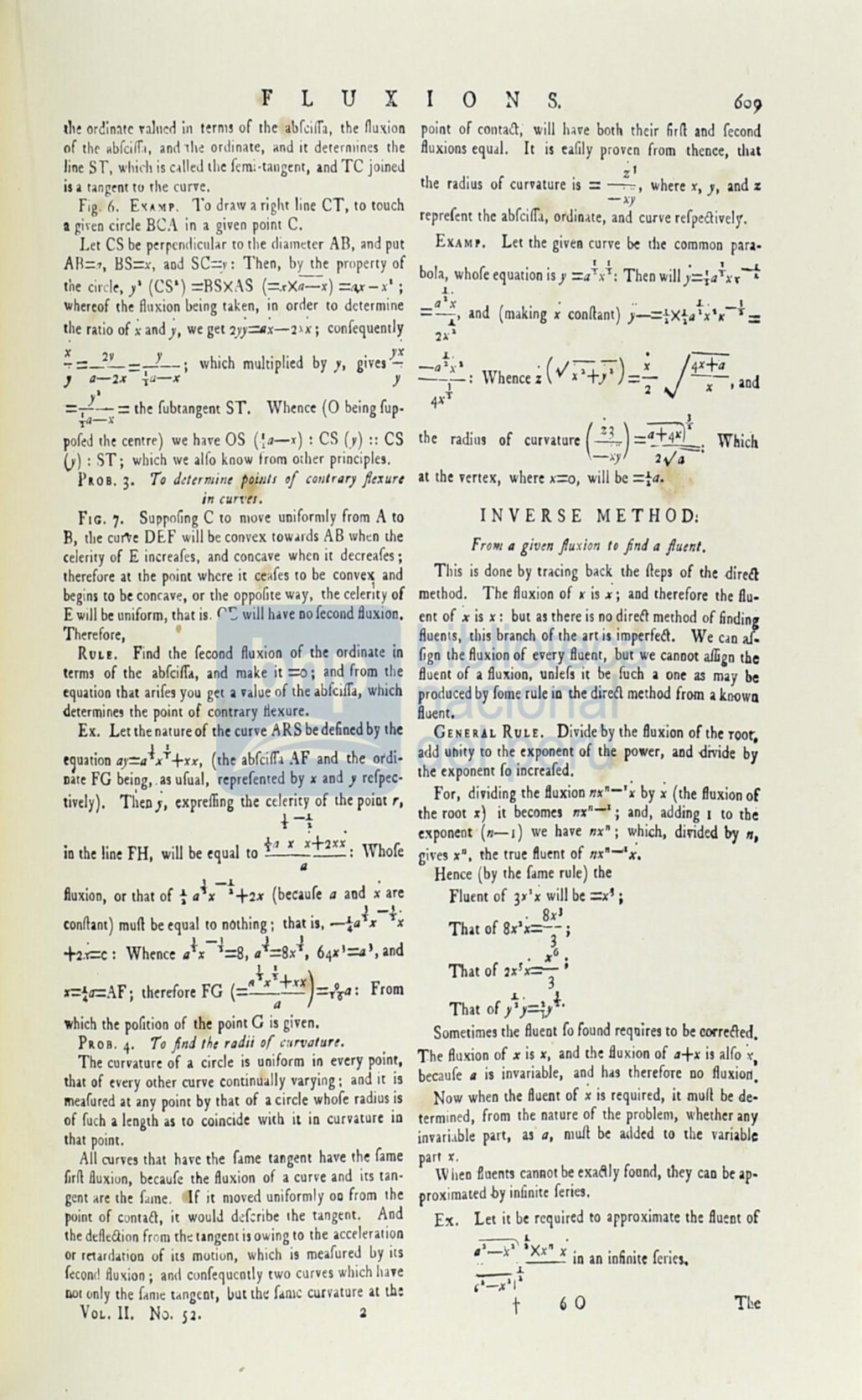

F
L
u
x
d,e
ordin~le
rallled iu lerol! of Ihe abf.iITa, lhe fluxion
of lhe ,bfcilf.. , and
,h~
ordinale, "nd il delerOlines Ihe
line
sr,
which is
c~lIeJ
lhe femi'laugeO!, and TC joineJ
is a langent
!O
the curve.
Fig. 6.
E~A:lt P.
1'0 draw a righl line CT, tO louch
a
giren cirele
BC!\
in a given point C.
Let CS be perrendicular 10 Ihe eliameler
An,
and pUl
AB=. , IlS=x, aod SC=,,': Then, by lhe pmpeny of
the cirde,
i
(CS' ) =RSXAS (::::.rX;;=x)
=4>'- x' ;
whmof lhe fiuxion beiog taken, in order 10 determine
t!1C ratio of
~
and
j,
we get
2yj=~-2'~ ; eonCequentl~
x
2Y
)'
h' h l ' l' d b
.
YX
.,. =- - =-;--;
W
le mu up le
y
y,
glvel-:
J
0-2.<
",u-x
y
=i~x
= the Cublangent STo Whence (O being Cupo
poC~J
lhe centre) \Ve have OS
(.!.-x)
:
CS
(y)
::
cs
0) :
8T; which we alfo koowfrom odler principies.
i'~OB .
3.
70 ddumillt poilllJ
o¡
(Olll,o,y jltxurt
in
(un'o.
Flc.
7.
Suppofing C to move uniformly from
A
to
B,
lhe cuJ"\>e
DEf
will becoovex
low~rds
AB
\Vhen lhe
celerilY of
E
increaCes, and concave \Vhen il decreafes;
therdore al lhe point \Vhere it ce.Ces tO be convex and
begins to be concave, or lhe oppofile way, lhe
celer:ly
of
Ewill be uniform, lhacis. (''.: will Iwe oofecond Buxion,
Therefore,
'
RUL!.
Find lhe fecond fluxion of lhe ordinm in
lerm! of lhe abfcilr., and make ic
:::o;
and from che
equacioo Ibal arifes you gel
a
valueof lheabCcilra, which
delermines che POiOI of contrary dexure.
Ex. Lec lheoarure of lhe curve
ARS
be de60ed by rhe
esuacion
ay=oié+xx,
(lhe abfciIT.
AF
.and lhe o/di–
OaJe
FG
beiog, .as uCual, reprefented by
x
and
y
reCpec.
live/y). TI;eo
j,
exprelling lbe celerilY of che poial
r,
i-{
ia lbe line FH, wil! be equal 10
t"
x
;+2 X;:
Whofe
11
fluxion, or cbal of
~ a!~-~+2X
(becauCe
a
aod ; are
connant) mun be equal tO norhing; lbal is,
-{a
4
.<
-.¡.~
+2.':::C:
Whenee
Il+x
-{=S,
a4=S~4,
64xl::aJ, and
(
Rt)+XX)
9
F
r.:!=AF
i
lliererore
FG
=--a
-
=1''1"'': rom
which che poficion of che poinl
G
is given.
PROB. 4'
r o
fini
Ihe ,adii o( ,·"'.olurt.
The curvalure of a cirele is uniform in every poinl,
Ibac of every olher curve continu.lly varying: and il is
rnearu red ac any poinl by chal of acirele whofe radius is
of Cueh a lenglh as 10 coincide Wilh il io curvalure iD
thal poinc.
AII
curves chal havc lhe fame tangenl have rhe fame
firn fluxion, beeaufe lhe fluxion of a curve and irs lan·
genl are rhe CJme. If il moved uniCormly
00
from Ihe
poinl of conuél, il woulJ
d~[;ribe
Ihe langenl. Aod
lhedcReélion fromlheungenl is owing co lhe accelerarion
Or retardarían of il! mOlion, \Vhich is meafureJ hy irs
r~eoncl
fluxion
i
ao<l conCequcntly IWO curves whichhne
DOI only lhe C'01e l.ngeal, hUI
lh~
C.mecurvacure at tbe
VOL.II.No.
52.
2
o
N
s.
poinr of cOlltaé't; will have borh Iheir
fidl
and fecond
fluxions equ.l.
!t
is eafily proven Crom rhcnce, that
I d ·
f
.
;
I
C
te
ra
IUS
o curvature IS
=- ... ,
where
x,
J,
and
%
- '"Y
repreCenc the abCciIT.I, orJinale, and curve refpeélivel)'.
EXAMP. Lel the given curve be Ihe common para-
b
I
r
"
I I
•
,-<
o a, wholC equalJon IS
y =a"'x"':
Then wiII
y={OT
XT •
{ .
a
X
.
'
..
L .
J
=-¡, and (maklng
x
connanl) y--=txto'x'x-
T
=
:2x
a
_Qf~ ,
.
(,,;~.,-)
;
j~
--1-:
Whencez
x'+J'
="2
~-,aod
4
XT
•
J
lhe radius of curvature
(-=-t)
="-+4")"' :
Wlric"h
- '"Y
2";
a
at rbe vertex, \Vhere
':::0,
will be =ta.
1N V
E
R
S E
M
E T
H
OD:
F'MI
a given j/u.Yion ro find a jI"mr.
This is done by tracing back c-he ¡¡eps of thedire&
mechod. The fluxion of
x
is ;; aod lherefore rhe Bu.
enc
oC
~
is
x :
but as lhete is no direé't merhod of finding
Buenrs, chis branch of Ihe art is imperfeél. We cao
ar.
fign rhe fluxion of every Buenc, bUI we canool aIligo che
Buent of a Auxion, unleCs il be fueh a one as may be
produced by fomerule iD the direél mechod frcm a
knoWQ
Buent.
GENERAL RULE.
Divide by che Buxion oflheroor.
add uhity
10
Ihe exponen! of che power, aud -divide by
lhe exponent
Co
increaCed.
For, dividing lhe fluxion
n."-·~
by; (che Buxion of
lhe rOOI
xl
il becomcs
/IX"-';
and, adding
I
co lbe
exponenl (n-I) IVe have
nx";
IV.hich, divided
by
11,
gives
x',
the lrue Rucnt of
nx·~'x.
Hence (by che fame rule) rhe
FlueO! of
3";
wiII be
=x~
;
. Sxl
Thac of
Sx'x:::--- ;
{
. x •
Thal of
2X
I
'3'
Thal of
}j=j,t.
Somelimes the Rueot fo found requires 10 be oorreaed.
T-he Ruxion of
x
i5
x,
and lhe Bu xion of
a+x
is alfo
~
becauCe • is invariable, and h., lhmfore 00 Ruxion'
Now when lhe Ruenl of
~
is required, il mufl be de:
termined, from che nature of lhe problem, whecher any
invari.lble parl, as
a,
muH be added 10 lbe variable
pan r.
\V
heo Buents cannot be exaélly foono, chey cao be
ap.
proximated -by infinile Ceries.
Ex. Let ic be required to approximale lhe HUCOl of
tri-x"
}Xx"
x'
.
. .
.
..
. -_ In an momce fenes.
__ .L
,._~l l l
t
6 O
Thc
















